
OUTCROP EXTENDS THE AGUILAR VEIN TO 4 KILOMETRES WITH HISTORIC ADIT VEIN SAMPLES UP TO 2,994 GRAMS SILVER EQUIVALENT PER TONNE

Outcrop Silver & Gold Corporation (TSX-V: OCG) (OTCQX: OCGSF) (DE: MRG1) is pleased to provide an update on its regional exploration and target generation program at its 100% owned Santa Ana high-grade silver project in Colombia. Outcrop continues to define the Aguilar- El Guadual corridor with mapping and sampling. The newly identified Jimenez target central to Aguilar- El Guadual defines a continuous 1.8 kilometre vein zone with veins in adits that assay up to 2,994 grams equivalent silver per tonne which suggests another high-grade outcropping shoot. The Aguilar vein is inferred to be continuous for 4 kilometres to the northeast through Jimenez and El Guadual to the Espiritu Santo target. Aguilar is up to 3.5 metres wide in some locations and native gold, silver, electrum and silver-bearing pyrargyrite are relatively common as strong epithermal textures overprint the two phases of mesothermal mineralization previously recognized at Santa Ana.
Highlights
- Prospecting, mapping, and sampling have extended the Aguilar vein 4 kilometres northeast through Jimenez and El Guadual to Espiritu Santo. Reconnaissance mapping suggests the Aguilar may be part of a vein complex with other parallel veins within a corridor 1.5 kilometres wide, similar to the Royal Santa Ana vein corridor to the north.
- Aguilar is complex with multiple parallel and intersecting veins. Vein intersections have the potential for local high-grade enrichment in shoots.
- Historic adits in the Jimenez target show an in-situ vein with up to 6.22 g Au/t and 2,436 g Ag/t, or 2,994 g eq Ag/t. Jimenez may provide another high-grade outcropping shoot.
- El Guadual appears to show a local gold-bias zoning with grades up to 19.35 g Au/t, possibly related to an observed younger overprint of epithermal mineralization.
- Current drilling (assays pending) suggests that native silver, electrum and silver-bearing pyrargyrite are more abundant at depth at Maras, San Juan and Naranjo. Discovery holes from the Maras shoot included drill intercepts of 1.85 metres of 7,609 grams silver equivalent per tonne including 0.54 metres of 11,927 grams equivalent silver per tonne and 4.69 metres of 909 grams silver equivalent per tonne (see news release June 13, 2022).
“The surface assays from El Guadual and Jimenez are exciting and show that the Aguilar-El Guadual trend offers very significant exploration upside,” comments Guillermo Hernandez, Vice President of Exploration. “The work performed by our regional exploration crew shows a continuous stream of targets are coming into the pipeline through systematic and thorough evaluations. After all results are received and interpreted, drill programs will be designed to test the Aguilar, El Guadual and Jimenez targets.”
“Santa Ana is without peer as a high-grade silver system in Colombia,” comments Joseph Hebert, Chief Executive Officer. “As we steadily increase the size of the vein system at Santa Ana and identify multi-kilogram equivalent silver in drilling and surface targets, we can start comparing Santa Ana to some of the world-world class silver vein systems in Mexico that actually have less cumulative kilometres of veins than Santa Ana. The potential our team has revealed on less than ten percent of the Santa Ana project, which provides more than 60 kilometres of vein zones to explore, is remarkable.
El Guadual and Jimenez targets
Regional generative exploration has connected the El Guadual and Aguilar targets (see news release May 09, 2022) with mapping and sampling identifying the Jimenez target (Map 1) consisting of a series of parallel to subparallel veins, some of which are observable in groups of adits from Spanish colonial mining. The colonial Spanish miners would have developed these adits where they recognized relatively higher silver grades. The El Guadual and Jimenez vein zone is complex, with multiple parallel and intersecting vein sets. The parallel veins, vein splays, and intersecting veins often occur within an interval 100 to 200 metres wide. This high density is important because multiple parallel high-grade shoots can occur closely spaced within parallel veins that comprise a broader vein zone.
In El Guadual, four of eleven significant rock samples assay over 1,000 g eq Ag/t, for an average of 1,475 g eq Ag/t, and with all significant assays averaging 902 g eq Ag/t. In Jimenez, three of five significant samples assay over 1,000 g eq Ag/t, for an average of 1,806 g eq Ag/t and with all significant assays averaging 1,244 g eq Ag/t.
Petrographic and fluid inclusion studies on Santa Ana core show a prevalence of two phases of mesothermal or relatively deep formation with ore fluids probably related to intrusive bodies. In the Jimenez segment of the Aguilar vein zone, locally stronger epithermal or relatively shallow formation textures are more common. Epithermal textures are typified by quartz bands that show symmetry on either side of a vein, open spaces within the vein and “bladed-type” quartz that forms as a replacement for calcite. These features are illustrated in Photos 1-4. The occurrence of these epithermal textures within Aguilar supports a later imprinted third phase of mineralization and may explain the relatively higher gold with the silver grades seen in Jimenez and El Guadual.
| Sample No | Type | Lithology | g Au g/t | g Ag g/t | Pb % | Zn % | g AgEq g/t |
| RX5897 | Float | Quartz Vein | 2.61 | 297 | 0.05 | 0.04 | 525 |
| RX5898 | Float | Quartz Vein | 4.54 | 226 | 0.05 | 0.02 | 619 |
| RX5878 | Float | Quartz Vein | 1.05 | 311 | 0.06 | 0.08 | 407 |
| RX5836 | Outcrop | Quartz Vein | 0.40 | 315 | 0.04 | 0.01 | 351 |
| RX5840 | Float | Quartz Vein | 1.47 | 398 | 0.10 | 0.14 | 534 |
| RX5727 | Float | Quartz Vein | 19.35 | 142 | 0.05 | 0.19 | 1,817 |
| RX5696 | Outcrop | Quartz Vein | 0.46 | 608 | 0.07 | 0.01 | 650 |
| RX5723 | Outcrop | Quartz veinlets | 2.76 | 863 | 0.06 | 0.15 | 1,110 |
| RX5724 | Float | Quartz Vein | 7.78 | 1,172 | 0.12 | 0.00 | 1,845 |
| RX5681 | Float | Quartz Vein | 0.47 | 885 | 0.03 | 0.18 | 936 |
| RX5682 | Float | Quartz Vein | 5.34 | 664 | 0.11 | 0.02 | 1,127 |
Table 1. Significant rock chips samples from El Guadual target.
| Sample No | Type | Lithology | g Au g/t | g Ag g/t | Pb % | Zn % | g AgEq g/t |
| RX5472 | Outcrop | Quartz veinlets | 4.51 | 851 | 0.14 | 0.24 | 1,255 |
| RX5474 | Outcrop | Quartz Vein | 3.36 | 867 | 0.30 | 0.12 | 1,170 |
| RX5476 | Outcrop | Quartz Vein | 1.17 | 291 | 0.22 | 0.02 | 400 |
| RX5478 | Float | Quartz Vein | 1.22 | 294 | 0.06 | 0.03 | 402 |
| RX5450 | Outcrop | Quartz Vein | 6.22 | 2,436 | 0.39 | 0.23 | 2,994 |
For table 1 and 2: Metal prices used for equivalent calculations were US$1,827/oz for gold, US$21.24/oz for silver, US$0.90/lb for lead and US$1.56/lb for zinc.
Table 2. Significant rock chips samples from the Jimenez target.
Drilling Update
Exploration drilling continues in Maras and Naranjo and definition drilling at depth in the San Juan shoot with three drill rigs. The San Juan and Maras shoots are along the Royal Santa Ana vein system. The Naranjo target is a parallel vein to the northwest. Initial drill results from the Maras shoot include drill intercepts of 1.85 metres of 7,609 grams silver equivalent per tonne including 0.54 metres of 11,927 grams equivalent silver per tonne and 4.69 metres of 909 grams silver equivalent per tonne (see news release June 13, 2022). These intercepts represent the highest-grade and thickest intercepts respectively drilled on Santa Ana to date. Las Maras remains open along the surface and at depth.
Notably native gold and silver, silver-rich electrum and silver-bearing pyrargyrite are observed in core in all three areas and native metals appear to increase with depth within the veins. In San Juan and Naranjo, native silver and electrum have been observed only in the deepest delineation drill holes. Visible precious metals in core generally correlate with higher grade assays. Drill-core assays are pending from Naranjo and Maras and then San Juan.
QA/QC
Core samples are sent to either Actlabs in Medellin or ALS Chemex in Medellin for preparation and then to ALS Chemex in Toronto or Lima, Peru for analysis. In line with QA/QC best practice, approximately three control samples are inserted per twenty samples (one blank, one standard and one field duplicate). The samples are analyzed for gold using standard fire-assay on a 50-gram sample with a gravimetric finish. Multi-element geochemistry is determined by ICP-MS using either aqua regia (ME-MS41) or four acid (ME-MS61) digestion. Comparison to control samples and their standard deviations indicate acceptable accuracy of the assays and no detectible contamination.
About Santa Ana
The 100% owned Santa Ana project comprises 36,000 hectares located in northern Tolima Department, Colombia, 190 kilometres from Bogota. The project consists of five or more regional scale parallel vein systems across a trend 12 kilometres wide and 30 kilometres long. The Santa Ana project covers a significant part of the Mariquita District, where mining records date back to at least 1585. The Mariquita District is the highest-grade primary silver district in Colombia, with historic silver grades reported to be among the highest in Latin America from dozens of mines. Historic mining depths support a geologic and exploration model for composite mesothermal and epithermal vein systems having mineralization that likely extends to great depth. At Santa Ana, it is unlikely that there is a sharp elevation restriction common to high-grade zones in many epithermal systems with no mesozonal component.
At the core Royal Santa Ana project, located at the northern extent of just one of the regional vein systems controlled by Outcrop, eleven high-grade shoots have been discovered – La Ivana hanging-wall and footwall (La Porfia vein system); San Antonio, Roberto Tovar, San Juan, Maras (Royal Santa Ana vein systems); El Dorado, La Abeja (El Dorado vein systems), Megapozo, Paraiso (El Paraiso vein system) and La Isabela. Each zone commonly contains multiple parallel veins. The veins can show both high-grade silver and high-grade gold mineralization, and low-angle veins appear to connect more common high-angle veins.
Outcrop drilling indicates that mineralization extends from surface or near-surface to depths of more than 300 metres. Cumulatively, over 60 kilometres of mapped and inferred vein zones occur on the Santa Ana project. The 100% owned Frias Mine on the south-central part of the project, 16 kilometres south of the Royal Santa Ana Mines, produced 7.8 million ounces of silver post-production in the Spanish colonial era at a recovered grade of 1.3 kg Ag/t. The Frias Mine is considered an analogue to each of the eleven shoots discovered to date by Outcrop. Between the Royal Santa Ana Mines and towards the Frias Mine, veins have been extended to the south providing strong drill targets in the Aguilar, Espiritu Santo and El Christo veins that show high values up to 5.5 kg AgEq/t and these veins show widths up to 4.7 metres. In total, vein zones have been mapped over more than 12 kilometres between El Dorado vein to the north and the Aguilar vein to the southwest. The Aguilar vein is inferred to be continuous for 4 kilometres to the northeast through Jimenez and Guadual to Espiritu Santo. Parts of Aguilar display strong epithermal textures that overprint the two phases of mesothermal mineralization previously recognized.
About Outcrop
Outcrop is rapidly advancing exploration on five silver and gold exploration projects with world-class discovery potential in Colombia. Outcrop is currently drilling and expanding the Santa Ana historic high-grade silver district. These assets are being advanced by a highly disciplined and seasoned professional team with decades of experience in Colombia.
Qualified Person
The technical information in this news release has been approved by Joseph P Hebert, a qualified person as defined in NI43-101 and President and Chief Executive Officer of Outcrop.
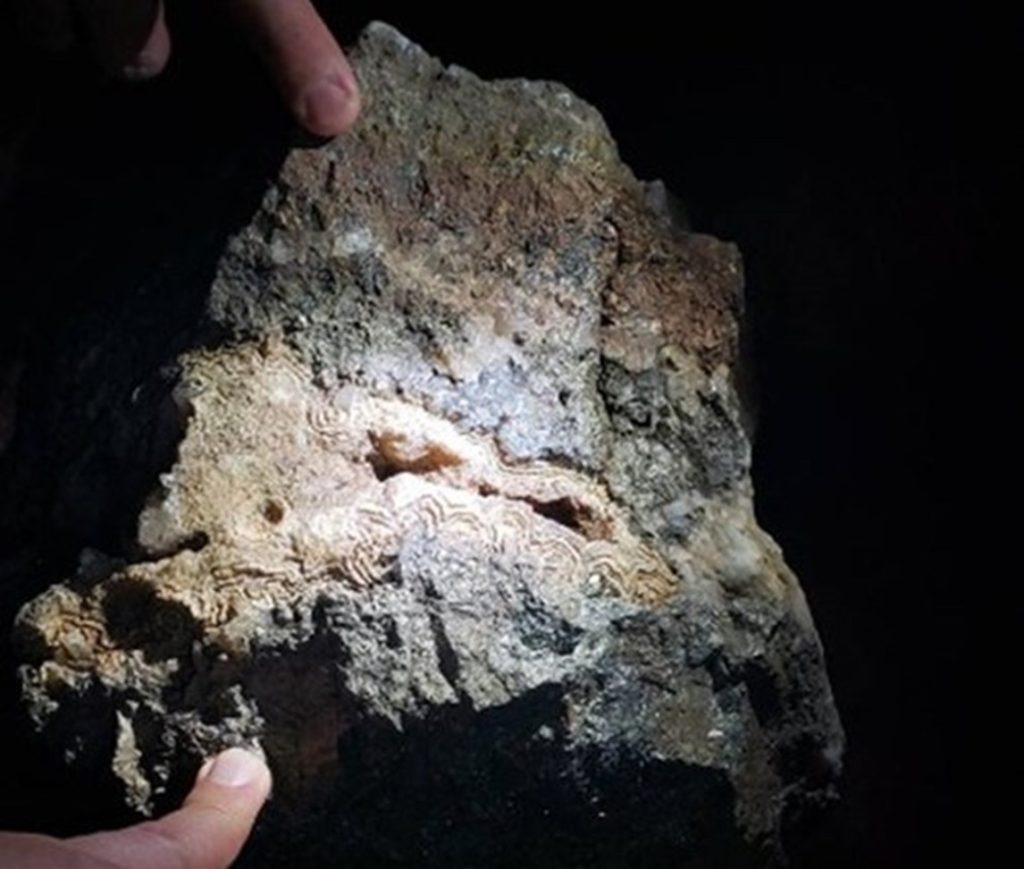
Jimenez and El Guadual show epithermal textures of symmetrical quartz banding and open space and bladed quartz. This later epithermal phase overprints two earlier phases of mesothermal mineralization and may explain the relatively higher-grade gold and enriched silver in this area. (CNW Group/Outcrop Silver & Gold Corporation)

Jimenez and El Guadual show epithermal textures of symmetrical quartz banding and open space and bladed quartz. This later epithermal phase overprints two earlier phases of mesothermal mineralization and may explain the relatively higher-grade gold and enriched silver in this area. (CNW Group/Outcrop Silver & Gold Corporation)
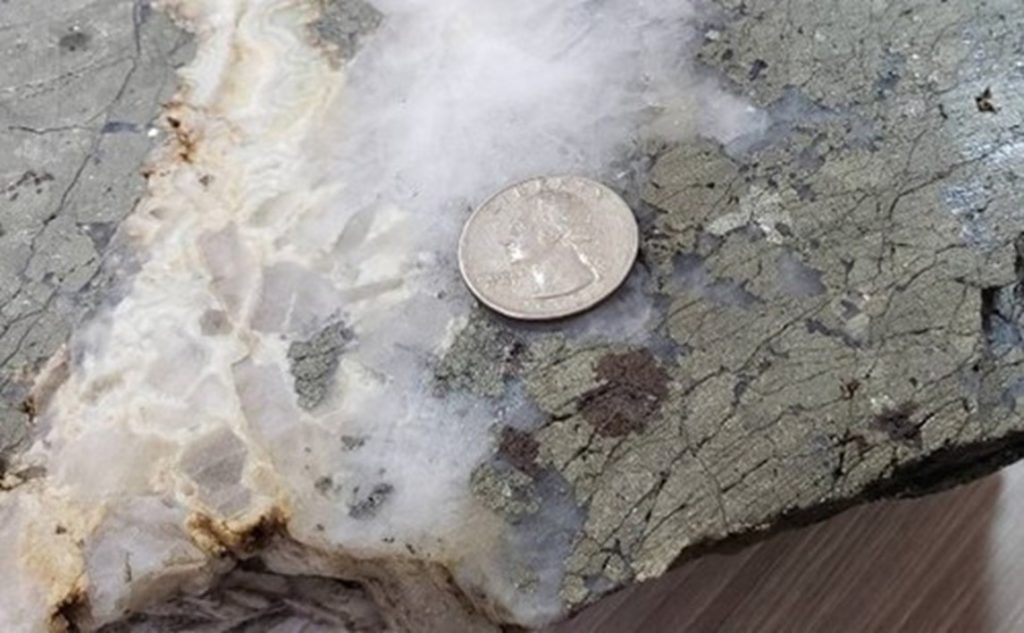
Jimenez and El Guadual show epithermal textures of symmetrical quartz banding and open space and bladed quartz. This later epithermal phase overprints two earlier phases of mesothermal mineralization and may explain the relatively higher-grade gold and enriched silver in this area. (CNW Group/Outcrop Silver & Gold Corporation)
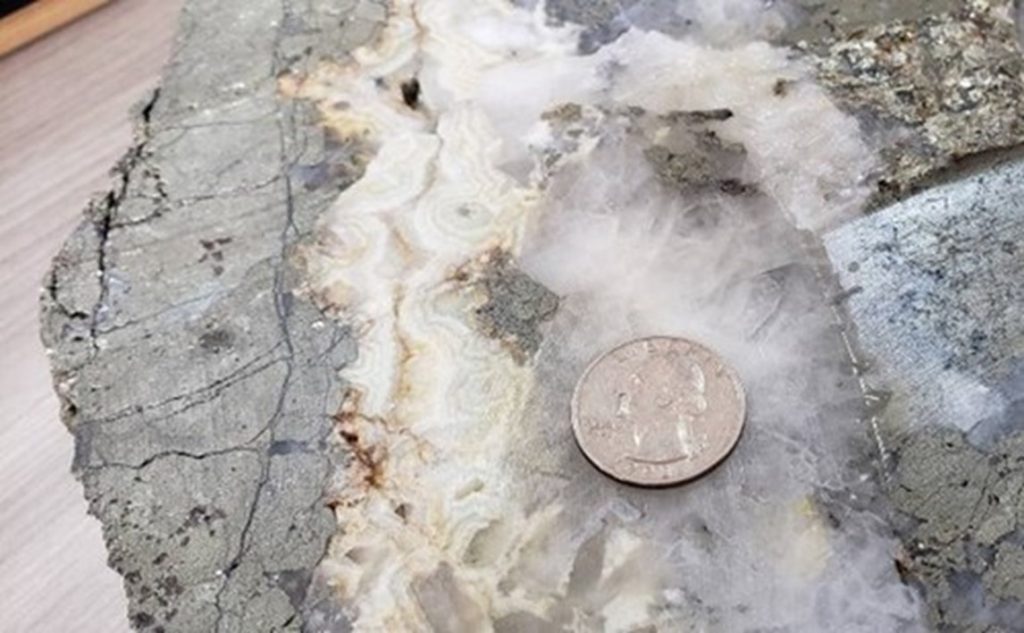
Jimenez and El Guadual show epithermal textures of symmetrical quartz banding and open space and bladed quartz. This later epithermal phase overprints two earlier phases of mesothermal mineralization and may explain the relatively higher-grade gold and enriched silver in this area. (CNW Group/Outcrop Silver & Gold Corporation)
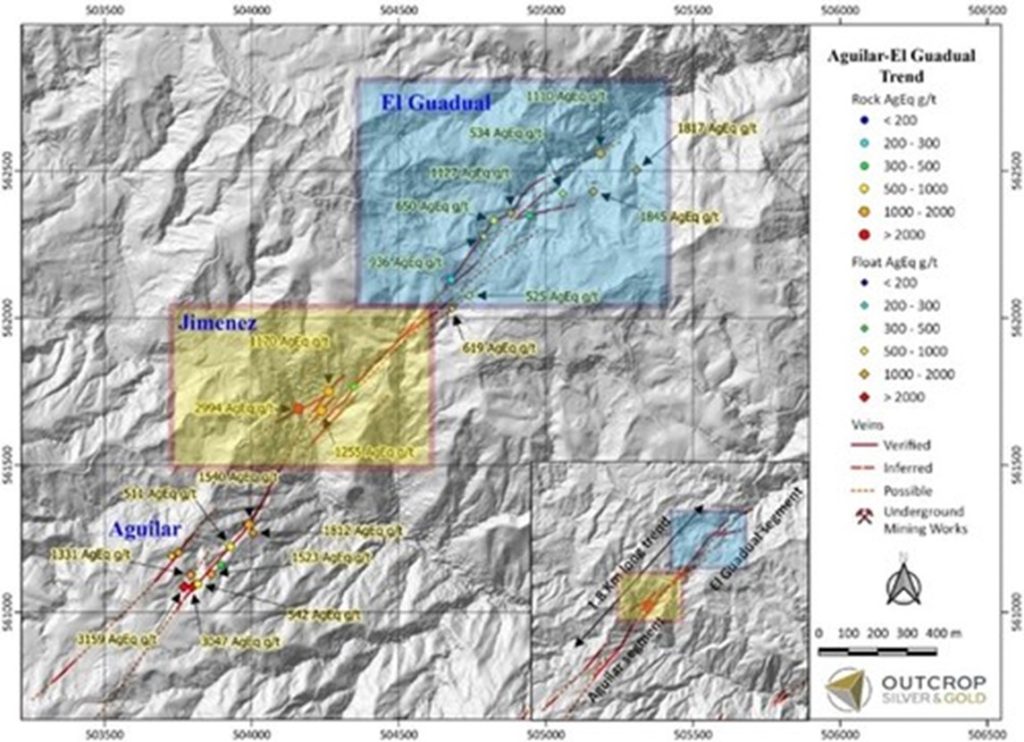
Map 1. The Aguilar-El Guadual trend can be traced for 1.8 kilometres in outcrop and float. This area is highlighted on Map 2, (CNW Group/Outcrop Silver & Gold Corporation)
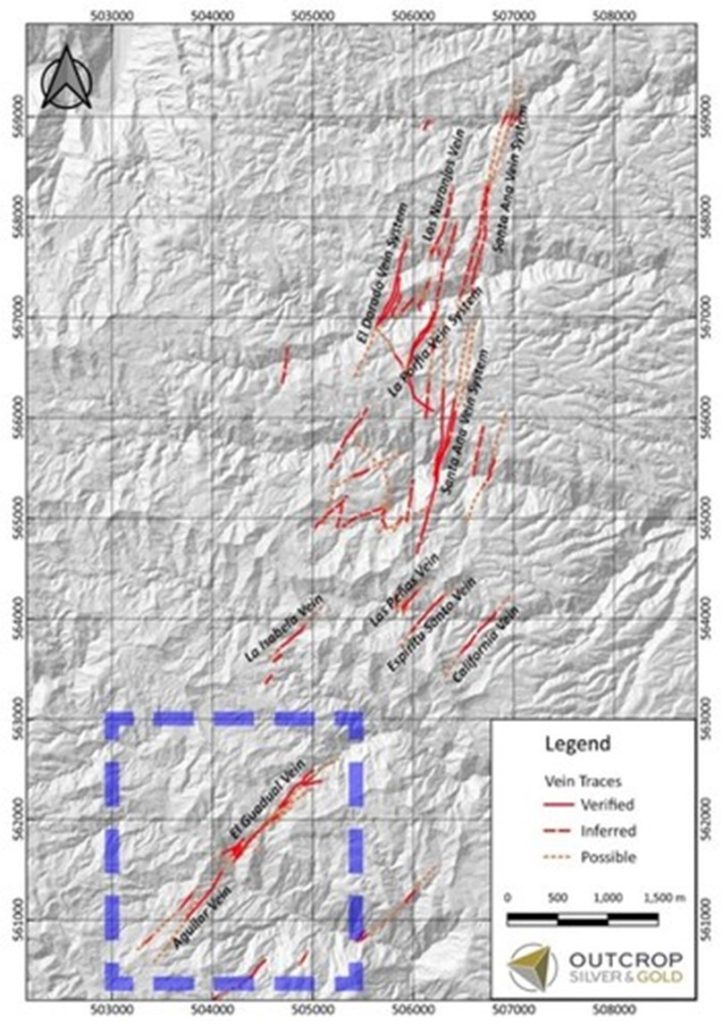
Map 2. Twelve kilometres strike of mapped veins zones at Santa Ana permitted for drilling. Reconnaissance mapping and prospecting suggest Aguiler could be part of a 1.5-kilometre-wide vein corridor, similar to the Royal Santa Ana veins to north, (CNW Group/Outcrop Silver & Gold Corporation)
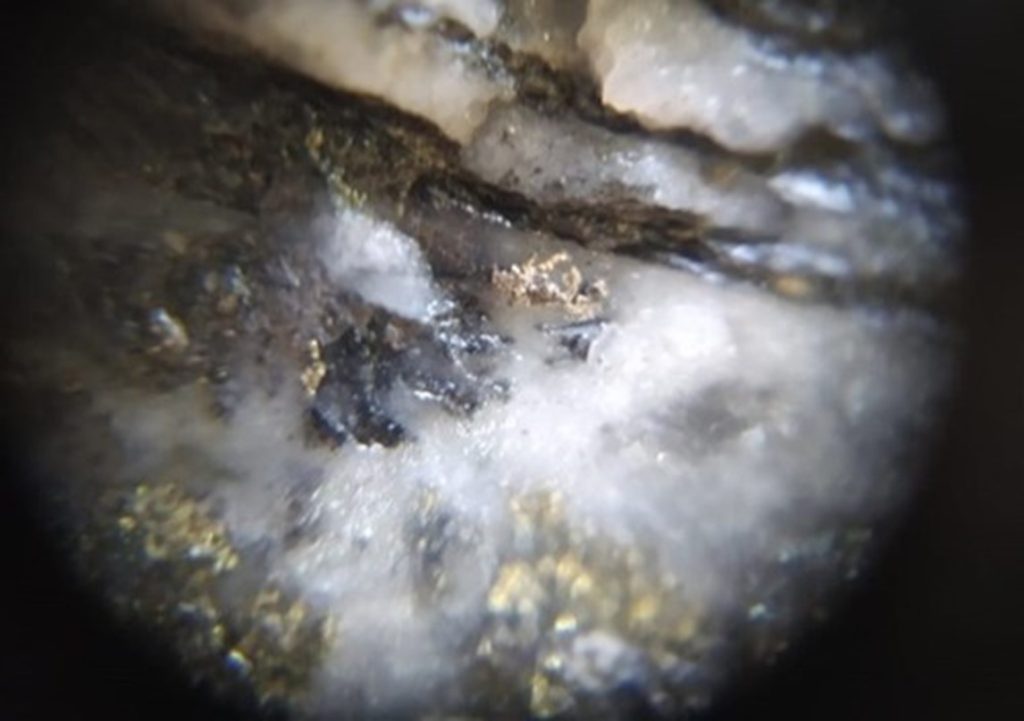
Coarse electrum in core from Naranjo. Assays pending. (CNW Group/Outcrop Silver & Gold Corporation)
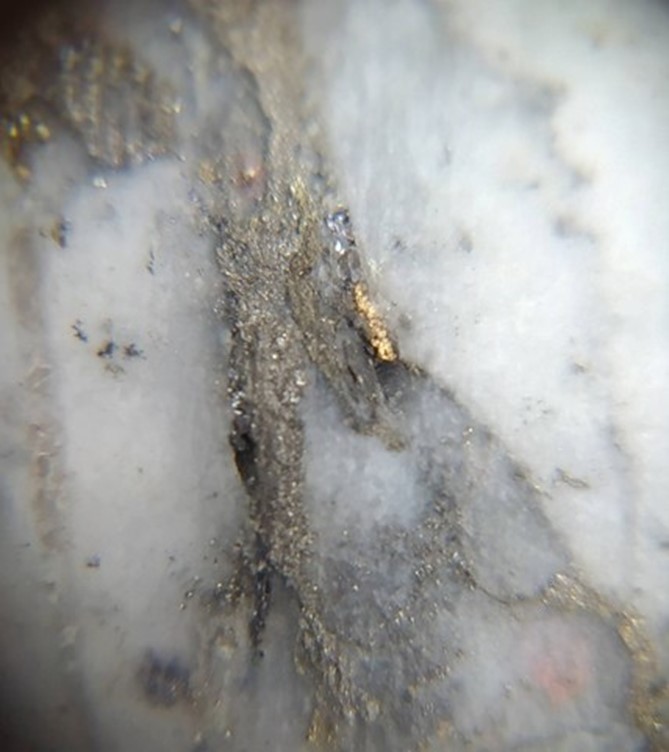
Coarse native gold in core from Maras. Assays pending. (CNW Group/Outcrop Silver & Gold Corporation)

Course pyrargyrite (pinkish silver-rich sulfosalt) and native silver from the deepest core in San Juan. Native silver and pyrargyrite have only been observed in the deeper parts of San Juan, suggesting mineralization is open and silver may be enriched at depth. Assays pending. (CNW Group/Outcrop Silver & Gold Corporation)
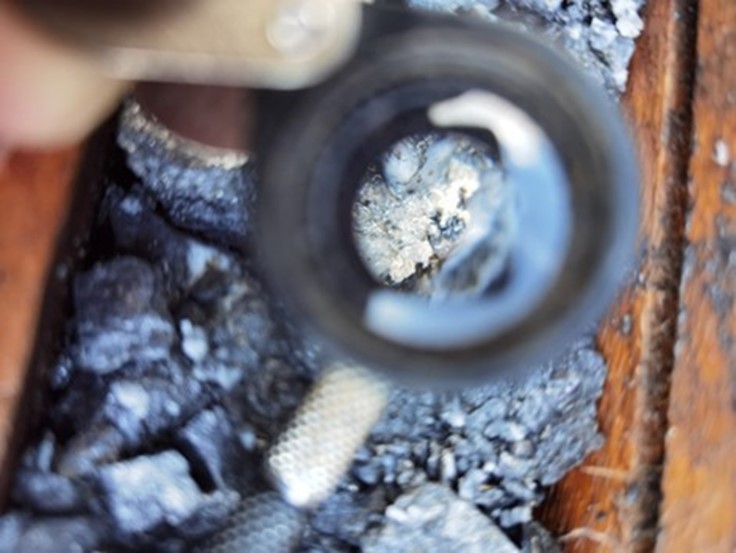
Course pyrargyrite (pinkish silver-rich sulfosalt) and native silver from the deepest core in San Juan. Native silver and pyrargyrite have only been observed in the deeper parts of San Juan, suggesting mineralization is open and silver may be enriched at depth. Assays pending. (CNW Group/Outcrop Silver & Gold Corporation)
MORE or "UNCATEGORIZED"
Quimbaya Gold Closes $4 Million Financing and Expands Executive Team
Cornerstone investor brings proven regional track record; company... READ MORE
Spanish Mountain Gold Announces Larger Scale Preliminary Economic Assessment With a Base Case NPV5% After-Tax of C$1.0 Billion, 18.2 % IRR and 3.4 Year Payback at US$ 2,450/Oz Gold Price; at US$3,300/Oz Spot Gold Price NPV5% C$2.3 Billion, 32.0% IRR and 2.0 Year Payback; Including an Updated Mineral Resource Estimate for Its Spanish Mountain Gold Project
Spanish Mountain Gold Ltd. (TSX-V: SPA) (FSE: S3Y) (OTCQB: SPAUF)... READ MORE
Aura Announces Preliminary Q2 2025 Production Results
Aura Minerals Inc. (TSX: ORA) (B3: AURA33) (OTCQX: ORAAF) is plea... READ MORE
Cascadia Announces Closing of Financing
Cascadia Minerals Ltd. (TSX-V:CAM) (OTCQB:CAMNF) is pleased to an... READ MORE
Abcourt Closes US$ 8M Loan Facility to Start Sleeping Giant Mine
Abcourt Mines Inc. (TSX-V: ABI) (OTCQB: ABMBF) is pleased to anno... READ MORE












